Think of a birding destination on the Iberian peninsula and chances are it will be somewhere in Spain; but what about Portugal? For far too long Portugal has been overlooked by most travelling birders but, as I discovered when I took a trip to the southern half of the country in October, there's so much more to Portugal than golf courses and villa resorts.
At the invitation of the Alentejo tourist board, I joined Jan Södersved, editor of BirdLife Finland magazine Linnut, and blogger Alan Tilmouth for a six-day tour of all that was on offer to a birder visiting the region. We were met at Lisbon airport by João Rolha and José Seno from Merturis — and by João Jara from Birds & Nature Tours, a former member of the Portuguese rarities committee, former BirdLife Portugal board member, ace birder, and our guide for the week.
Adjacent to Lisbon lies the Tagus Estuary, one of Europe's largest estuaries, spanned by Europe's largest bridge and within easy reach of the airport. After a short 20-minute drive from our arrival point, we reached some rice fields that lie close to the estuary. Here, we immediately found a host of species typical of southern European wetlands: massed ranks of White Storks and Greater Flamingos accompanied by Glossy Ibis, Black-winged Stilts, Spoonbills, a Purple Gallinule and half a dozen Great White Egrets. There were flocks of passage waders, most Black-tailed Godwits with smaller numbers of Ruff and Spotted Redshank mixed in, while a pair of Black-winged Kites sat motionless in the shade of an irrigation pipe. Of non-avian interest, the marshes were heaving with darters — mostly, from what I could see, Red-veined.
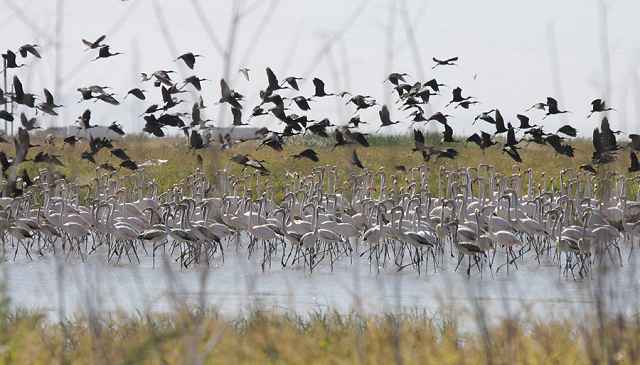
Glossy Ibis and Greater Flamingos (Stephen Menzie).
After a spot of lunch in a local restaurant, we visited some salt pans adjacent to the estuary. Here, we found huge numbers of Kentish Plovers along with smaller numbers of Ringed Plovers, Sanderlings, and a Little Stint. Moving on to some marshland on one arm of the estuary, we discovered more Black-shouldered Kites (becoming more active as the temperature cooled and giving some stunning views as they flew past at close range), several Ospreys, a Peregrine and, in the farmland next to the marsh, our first Spotless Starlings and Azure-winged Magpies of the trip. We finished our Tagus Estuary tour with a look at the exotic species that have established feral populations in the area: Black-headed Weavers, Common Waxbills and Yellow-crowned Bishops, all visible along the same stretch of reedy ditch.
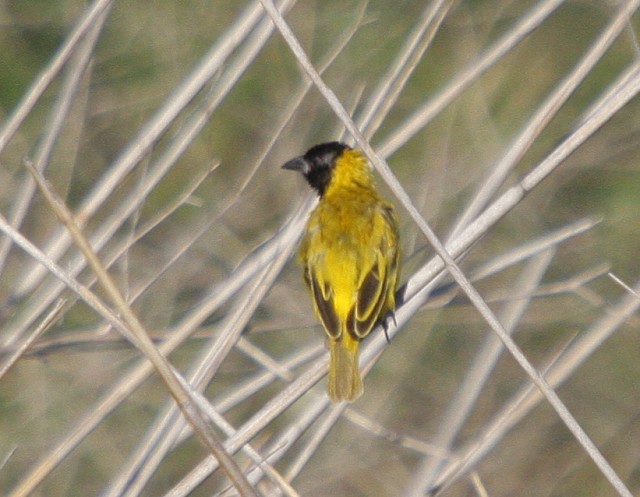
Black-headed Weaver, Portugal (Photo: Stephen Menzie)
Having filled our boots with all that was on offer around Lisbon, we headed inland. Within 90 minutes, we were in bustard country. And there is the first advantage of birding in Portugal: the distances, and thus the travelling time, between the key habitats are small and don't require the long road trips between sites. In the morning you can be watching a host of coastal species; by the afternoon you can find yourself in the middle of extensive steppeland. Sadly for us, though, the sun was setting and we had to save the bustards for another day.
Mértola, where we would be staying, is a beautiful town in the east of Alentejo province. Our hotel, the Hotel Museu, overlooked the valley of the Guadiana River, which runs through the town. The name of the hotel, in case you're wondering, comes from the small museum hidden beneath the hotel, for not only is Mértola a beautiful town but also a historic one. History on the site dates back to the Phoenicians, followed by the Carthaginians, the Romans, and the Moors. The Moorish influence is particularly strong, with Islamic architecture dominating the narrow streets of the old town; indeed, the town's magnificent church was originally a mosque.
Birding started as soon as the curtains were opened in the morning. One could sit on the balcony pre-breakfast and notch up a list of mouthwatering species: Crag Martin, Red-rumped Swallow, Blue Rock Thrush, Azure-winged Magpie...and the birding out of town was even better still.
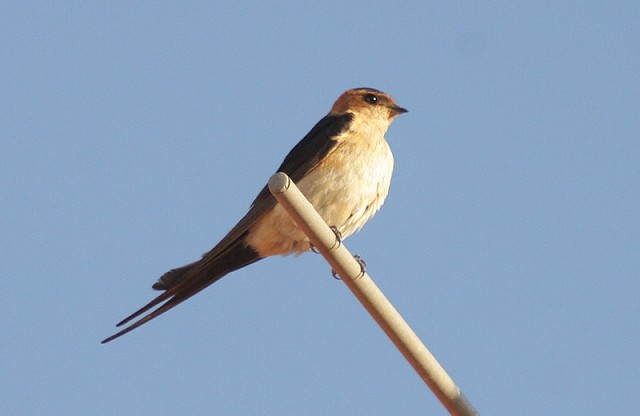
Red-rumped Swallow, Mértola, Portugal (Photo: Stephen Menzie)
Much of the area to the west of Mértola, towards the town of Castro Verde, consists of prime pseudo-steppe farmland, much of it managed for the benefit of steppeland species. A short stop along the road to Castro Verde saw us adding Black Vulture and Short-toed Eagle to the list, as they soared with a group of Griffon Vultures. Out on the steppe, we regularly came across small groups of Great Bustards; Little Bustards were around, too, though harder to spot as they kept themselves hidden in stubble. Southern Grey Shrikes were common, Thekla Larks and Crested Larks kept us company wherever we went, and Hoopoes would regularly burst up from the track in front of the car with a flap of black-and-white butterfly wings. Common Kestrels were numerous but most Lesser Kestrels had left already; however, at an old farmstead — now an up-market kestrel des res complete with nestboxes and artificial wall cavities — we managed to find a late-staying male catching insects over the steppe.
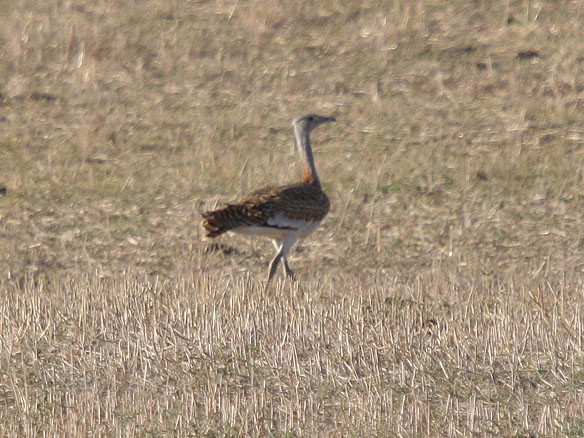
Great Bustard, Portugal (Photo: Stephen Menzie)
White Stork nests topped every telegraph pole, though their inhabitants had now departed. We did encounter a handful of Black Storks, though, passing through in twos or threes. João took us to an area in which he hoped we would find Black-bellied Sandgrouse and there, sure enough, we found a small flock of this fantastic species; then onwards to a site where he thought we might see Calandra Lark. Once again, João was right and there was a flock of Calandra Larks by the side of the track, largely invisible until they took flight.
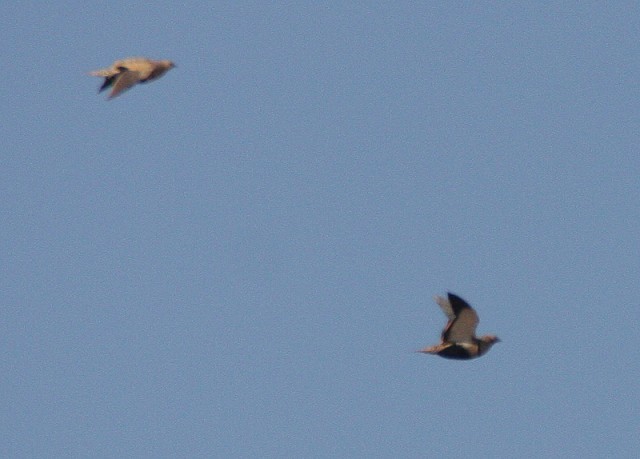
Black-bellied Sandgrouse, Portugal (Photo: Stephen Menzie)
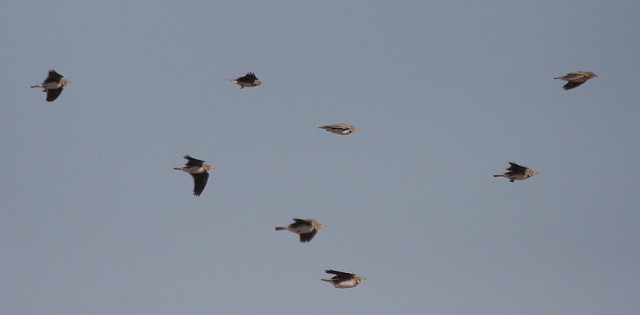
Calandra Lark, Portugal (Photo: Stephen Menzie)
A memorable moment came when João spotted four large raptors high ahead in the distance. It was obvious that they weren't Griffon Vultures, Marsh Harriers or Red Kites, which we had been seeing regularly throughout the trip; nor were they Black Kites, Short-toed Eagles or Black Vultures, all of which we had already seen that morning. As they drifted closer it became clear that the four birds were two species: a pair of subadult Bonelli's Eagles chasing off two immature Spanish Imperial Eagles! All four birds drifted over our heads with one of the Spanish Imperial Eagles calling as it did so — an almost Raven-like kowk-kowk-kowk. João had told us that this area was great for finding Spanish Imperial Eagles so it was a species we were half-expecting, but two together in the same binocular view as two Bonelli's Eagles was not something we'd expected.
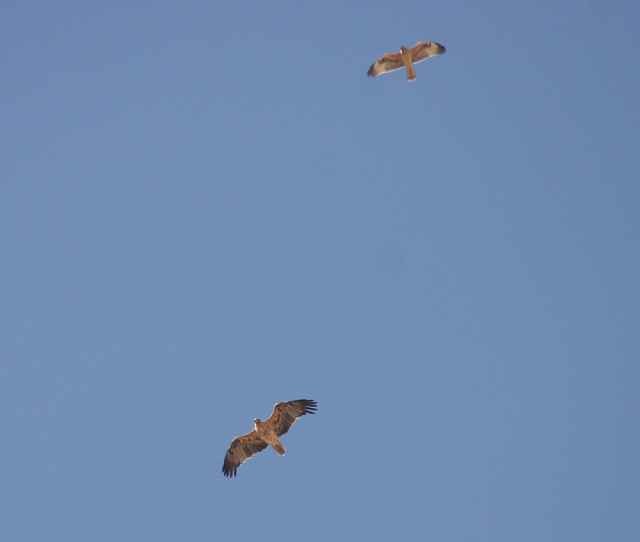
Spanish Imperial Eagle and Bonelli's Eagle (Stephen Menzie).
We spent one full day at Parque de Natureza de Noudar near to the town of Barrancos on the Spanish border. The view over the river, which forms the border, was certainly one of the most breathtaking views of the trip. An Otter swimming from the Spanish side to the Portuguese side and clouds of Crimson Speckled moths were an added bonus.

The view into Spain (Stephen Menzie).
We explored some of the park trails where we found many species typical of the patchwork of oak woodland and rocky river valleys: Rock Sparrow, Cirl Bunting, Mistle Thrush, and Sardinian Warbler. The now abandoned fortification of Noudar village was home to large numbers of Crag Martins, while in the skies above a White-rumped Swift was an extremely pleasant surprise.
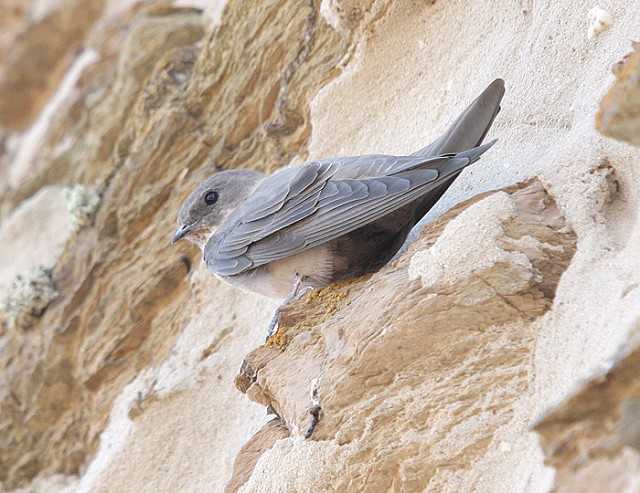
Eurasian Crag Martin, Portugal (Photo: Stephen Menzie)
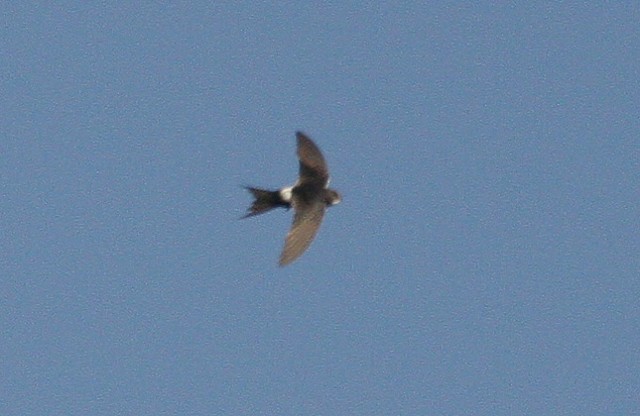
White-rumped Swift, Portugal (Photo: Stephen Menzie)
South of Alentejo lies the region of Algarve. Better known as a holiday destination than a birding location, we took a day trip here to experience some of what the south coast has to offer. From Mértola to the Algarve coast was a mere hour's drive, something worth thinking about if you're off for a family holiday: the bustards and sandgrouse may not be as far away as you might think!
We started the day with a boat trip out into the coastal lagoon near Tavira. Here we found a Slender-billed Gull, a host of waders (Whimbrel, Bar-tailed Godwit, Grey Plover) and, on the muddy banks of the lagoon, a carpet of European Fiddler Crabs. At Tavira salt pans we found more waders, adding Curlew Sandpiper to our list, along with several Caspian Terns and a flock of Audouin's Gulls.
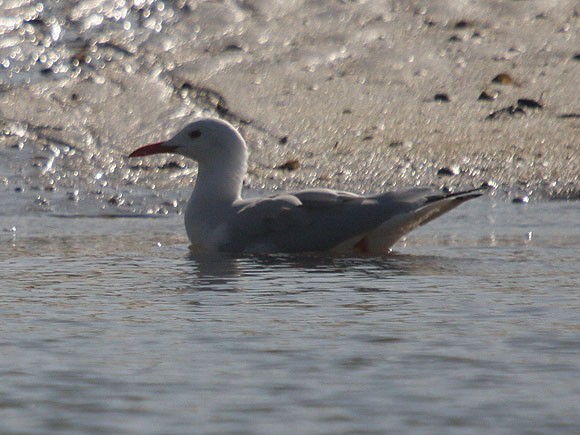
Slender-billed Gull (Stephen Menzie).
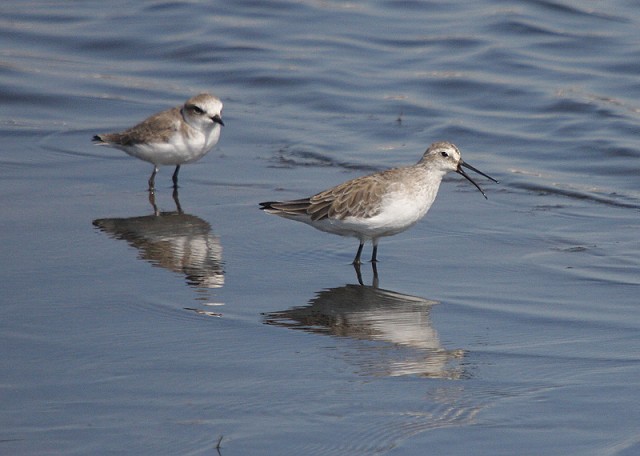
Kentish Plover and Curlew Sandpiper, Portugal (Photo: Stephen Menzie)
Further east, heading towards the famous Quinta do Lago golf course, we found more Caspian Terns, a Little Tern and a Common Tern as well as the by now 'usual' salt-pan species. A Booted Eagle circled overhead while a Black-shouldered Kite perched in a nearby tree. At Quinta do Lago pool we had excellent views of Purple Gallinule, with up to eight being visible from the hide at any one time; also on the lagoon were Red-crested Pochard, Pochard, a male Tufted Duck and a juvenile Little Bittern. We finished our day on the Algarve at a wonderful reserve right in the southeast corner of the region.
Reserva natural do Sapal de Castro Marim e Vila Real de Santo António is a series of working salt pans in the very southeast corner of Algarve, managed with wildlife in mind. Our tour of the reserve was all too brief with the sun disappearing behind the horizon before we'd had a proper chance to explore but, even in our short time there, we could see what an excellent place it was — we saw hundreds of waders feeding in the salt pans along with large numbers of Spoonbills and Greater Flamingos. Lesser Flamingo has been recorded on more than one occasion and the site hosted Portugal's first breeding Audouin's Gulls. After sunset, we headed back to the reserve centre to enjoy some locally grown fig jam and to watch a presentation given by the reserve staff to find out more about their work — I was very impressed with the integrated nature of the reserve's work.
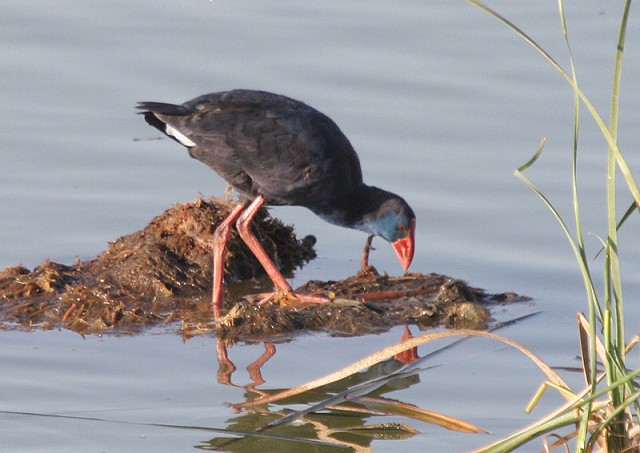
Purple Gallinule, Quinta do Lago, Portugal (Photo: Stephen Menzie)
Castro Marim wasn't the only place that left a lasting impression. Everywhere we went we were greeted by friendly and well-informed staff, be they working on a reserve or natural park or from a local tourist board; all spoke perfect English; and every site we visited had information — both general and specifically for birding — freely available in multiple languages. Reserves were well equipped for visitors, all with well-marked trails and pamphlets. Parque de Natureza de Noudar, in particular, had worked extremely hard to enhance the visitor experience: visitors can take a walk along one of the many trails with a GPS-enabled PDA to allow real-time access to information about what they can see around them, while those wishing to travel further into the park can borrow an electric golf buggy to get around. The reserve also offers accommodation starting at €15 a night. During our stay, we were treated to numerous visits to non-birding attractions in the area: from the fascinating mines at São Domingos, and the brand new rural museum in Castro Verde. We also visited a wide range of restaurants, from those in swanky hotels to small rural affairs; the standard of the food throughout was superb. I can recommend the asparagus migas, the Alentejo "black" pork, the "convent" puddings, the seafood, the local cheeses...and the local wines, for that matter.
Over the week, despite the 34°C temperatures we encountered and the late date of the trip, we comfortably amassed a list of 140 species — if we could see so many species, and good species at that, in unseasonably hot conditions in October, just imagine how productive a trip to Portugal in late spring could be! There's also an 'under-watched' feel to Portugal: so much potential and yet so few birders. The combination of an extensive Atlantic coastline and its being 'the end of the road' for many eastern birds moving southwest through Europe mean there's serious potential for finding your own rarities from any point of the compass.
With cheap flights to the region, great food and a wide choice of accommodation, fantastic friendly people who speak excellent English, an excellent road network, key habitats within no more than an hour or two's drive of each other, and brilliant birds, Portugal has definitely shown itself to be a magnificent location for a continental birding break.
Acknowledgements
There are several people who require a massive thank you for helping to make our trip what it was. First, to João Jara, our guide for the week. His knowledge of birds and birding in Portugal is vast and, crucially, he is always more than happy to share this knowledge. He runs his own company, Birds & Nature Tours, organising a variety of tours, details of which can be found on his website: www.birds.pt.
Secondly, to Rosinda, José and (especially) João (our chauffeur for the week) at Merturis. They did an excellent job of ensuring that our trip ran smoothly, that we got to visit many interesting places, and organised our flights from Heathrow to Lisbon with TAP Portugal. More information about Mértola can be found on their website: www.merturis.pt.
Finally, to the Alentejo tourist board, who funded the trip. The region proved to be a magnificent birding destination; more details can be found on their website: www.visitalentejo.pt. For anyone visiting Portugal, the following links will, I hope, provide additional helpful information for getting the most out of your visit:

